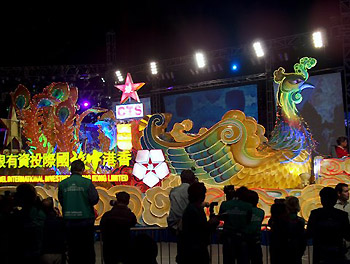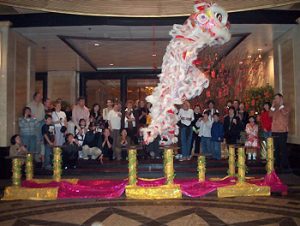
Hong Kong
by Sandra Scott
 Kung hei fat choy! Happy Chinese New Year!
Kung hei fat choy! Happy Chinese New Year!
I was fortunate to be in Hong Kong during Chinese New Year. It was a wonderful opportunity to learn as much as we could about the traditional celebrations. From our Western viewpoint, Chinese New Year is like Thanksgiving, Christmas and New Year celebrations all rolled into one. It is a time to give thanks, celebrate with the family, and look forward to a new year with optimism.
Even though the western solar calendar based is in common usage throughout most of the world, all Chinese people are also familiar with the Chinese calendar based on the cycles of the moon. In a systematic rotation each year honors a specific animal with its own special personality and characteristics. Stores and streets are decorated with many displays featuring the animal of the year.
Hong Kong has one of the most elaborate Chinese New Year Celebrations. It is a city of modern skyscrapers. Most of the buildings have huge neon holiday decorations on the entire side that faces the harbors, some of which are 30 stories high.
 “Kung hei fat choy” is the traditional New Year greeting; it means, “Wishing you success and prosperity.” Like all holidays worldwide Chinese New Year is set in tradition. Houses are cleaned to a fare-thee-well and decorated with flowers. A trip to the flower market is essential especially to get a kumquat or tangerine tree, which would be like a Christmas tree in the Western world. Kumquats and tangerines are considered symbols of good luck because they are golden, the color that signifies money. The word for tangerine in Chinese has the same sound as the Chinese word for “luck”. The most common flower for Chinese New Year is the narcissus. If it blossoms on New Year’s Day, it is an indication of good fortune. Every facet of Chinese New Year has a special meaning.
“Kung hei fat choy” is the traditional New Year greeting; it means, “Wishing you success and prosperity.” Like all holidays worldwide Chinese New Year is set in tradition. Houses are cleaned to a fare-thee-well and decorated with flowers. A trip to the flower market is essential especially to get a kumquat or tangerine tree, which would be like a Christmas tree in the Western world. Kumquats and tangerines are considered symbols of good luck because they are golden, the color that signifies money. The word for tangerine in Chinese has the same sound as the Chinese word for “luck”. The most common flower for Chinese New Year is the narcissus. If it blossoms on New Year’s Day, it is an indication of good fortune. Every facet of Chinese New Year has a special meaning.
Like Western holidays it is traditional for the whole family gather for a huge meal with fish being the most important food because the Chinese word for fish sounds like the word for abundance. During Chinese New Year it is traditional to give children red envelopes with money inside. These are called lai see envelopes which means “lucky.”
On New Year’s morning we awoke at the Langham Hotel to find a red silk bag on our doorknob filled with New Year goodies – traditional candies and gold covered chocolate coins. To usher in the year there was a Lion Dance in the lobby to bring good luck and happiness in the New Year. The Lion (two people in a lion costume) danced around to the beat of the large drums and clanging of the symbols. One of the most amazing aspect of the performance occurred when the Lion had to stand on his back legs and jump up to reach pieces of lettuce that were hanging from the high ceiling. The word lettuce sounds like money in Chinese. The Lion Dance was very loud, exciting, and concluded some amazing acrobatic movements. The Dance tradition been popular for over 1000 years and most neighborhoods have similar version.
 Hong Kong hosts a magnificent parade, which can be watched in a traditional manner from the street, but we were lucky enough to get tickets for the finale. For more than an hour the marching and performing units paraded through the arena pausing to put on a short performance. There were floats and performing units doing their own traditional dances from many countries. The next night we joined thousands of people along the waterfront to watch the amazing fireworks.
Hong Kong hosts a magnificent parade, which can be watched in a traditional manner from the street, but we were lucky enough to get tickets for the finale. For more than an hour the marching and performing units paraded through the arena pausing to put on a short performance. There were floats and performing units doing their own traditional dances from many countries. The next night we joined thousands of people along the waterfront to watch the amazing fireworks.
Essentially all business comes to halt during Chinese New Year, which lasts well over a week. Even though there are many public celebrations, for the Chinese New Year’s week is a time for family and for some the only vacation of the year, therefore everyone tries to be with their family. We felt especially fortunate to be able to ring in the new year twice – once in the US and once in Hong Kong.
January 26, 2009 begins the Year of the Ox, 4707 according to the Chinese New Year. The ox is a symbol of growth and stability.
Kung hei fat choy! Happy Chinese New Year!
For more information:
First Day of the Year of the Ox falls on 1/26/2009.
2009 is the Year of the Ox, which is also known by its formal name of Ji Chou.
Chinese New Year on Wikipedia
About the author:
Sandra Scott is a retired history teacher and the co-author of two local history books. Scott has been traveling worldwide and writing about her travels since 1990. Her retired husband, John, is her traveling/writing partner. Their travels have taken them to over 100 countries, some several times. Along with several columns, their work has appeared in a variety of publications worldwide.
www.sanscott.com
All photos are by Sandra Scott.




Leave a Reply
You must be logged in to post a comment.